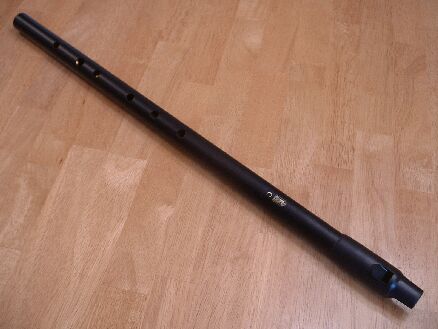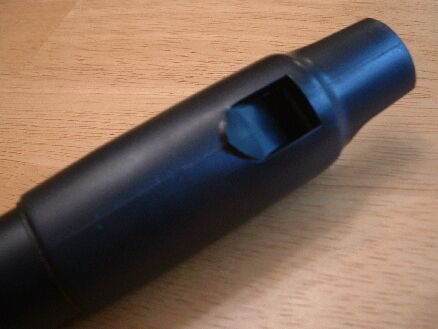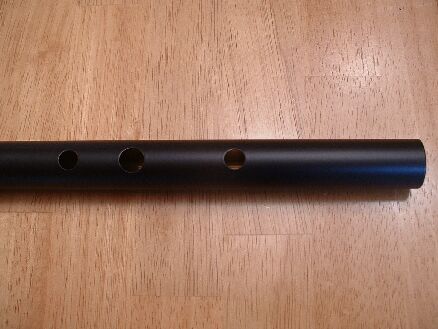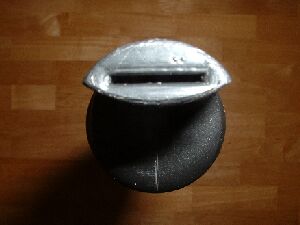Maker - Howard Music (Brian Howard) www.howardmusic.co.uk
Material - Brass Body with ABS Plastic Head
Dimensions: Length - 24 1/2" (with head pushed all the way in)
Distance between 1st and 3rd bottom holes - 3 1/4ths"
Diameter of 2nd hole from bottom - 7/16ths"
Bore - 1"
Weight - 7.5 oz
Price at time of review - 100.28 lbs direct from Maker, $135.00 US from distributor
After
my love/hate relationship with my first Howard low D, I decided I
wanted to try a Low C as well. I purchased this whistle from Hobgoblin
music USA.
Howard head joints have gone through many versions/upgrades since they were first offered in 1985 (On an interesting side note, the first Howard's were made in the early 1970's, just a few years after the invention of the modern Low whistle. See the History section for more). This whistle has the newest version of the head released the beginning of 2007.
Howard head joints have gone through many versions/upgrades since they were first offered in 1985 (On an interesting side note, the first Howard's were made in the early 1970's, just a few years after the invention of the modern Low whistle. See the History section for more). This whistle has the newest version of the head released the beginning of 2007.




Appearance:
A
common nickname for the Howard Low D is the "Generation on Steroids",
and there is certainly something about the plastic headpiece that just
looks, well, big. This particular whistles brass body has been anodized
black, making it what my goth friends would call "tragically hip".
Seriously though, the combination of the black body and black mouth
piece, along with the gold logo and hints of brass coming from the
inside and bottom of the body make for a visually striking whistle.
Basically the same in appearance as the black Howard Low D I
previously reviewed (yes, I pilfered a good deal of this review from
that one), the two major differences are length and distance between
finger holes. The additional length creates the optical illusion that
the Low C is thinner than the Low D, but they actually both have the
same bore size. I do not usually comment on the distance between holes
or finger stretch required in a review for a couple of
reasons. One is that everyone's hands are different, and what
might be a stretch for one person would be fine for another.
Second is that I always list the distance between the bottom
three holes under the Dimensions section at the top of the reviews.
That said, I will mention here that the finger stretch on this whistle
for me was noticeably large, and I have pretty large hands with fairly
long fingers.
Tone: In my review of the Howard Low D, I stated that "The first octave has a distinctive, gravely, nasal tone, reminiscent of a bagpipe or other reed instrument." To get the tone of the low C, just multiply that about three times. In fact, the first octave is so nasally that it really doesn't sound like a low whistle at all! (On a side note, Tony Hinnigan, in a review of a Howard Low C just like this one, stated that what he liked about the instrument was all the strange un-whistle like noises he could make with it) Also, unlike the Low D, this tonal quality continues partially up into the second octave as well. The whistle has a large amount of chiff, however, the new head joint does seem to cut down on the amount of breath apparent in the tone.
Volume: I would describe the volume of this whistle as being moderate/quiet in comparison to other Low D's. Unlike the Low D it is not well balanced in volume between the octaves, with the first octave being much softer than the second. One would likely not be heard in any but the quietest of session environments.
Backpressure/air requirement: This whistle has moderate to high backpressure, making for a relatively low air/breath requirement. However, the first octave breaks easily, and you have to blow/breath very gently. The second octave on the other hand has a large amount of noticeable backpressure that you can lean into a great deal. While this whistle may not require allot of air, it does demand good breath support, especially in the first octave.
Responsiveness: Considering it's size, this whistle is surprisingly fairly responsive, a feature/benefit of the new version head.
Clogging: I did not experience any clogging issues with this whistle, however, allot of moisture ended to collect on the blade ramp. This did not appear to affect the sound.
Tuning: While almost all of the notes on this whistle could be played in tune, each note seemed to require a different level of air/breath pressure to push or drop into tune. Most whistles tend to require less pressure on the bottom notes, with each subsequent higher note logically requiring more. But there seemed to be no rhyme or reason to this whistle, with some higher notes requiring that you back off and some lower notes requiring that you push. The only note that could not be blown into tune was the E, which was 20 cents flat. This whistle whistle requires the use of the 0XXX00 fingering for the Bb, but you have to be very careful, as it is easy to blow it sharp.
Sound clip: Leaving Lismore
Summary: Although I eventually came to enjoy the distinctive sound of the Howard Low D, I personally feel that the Low C just goes to far, almost to the point where I don't want to call it a Low whistle, but some new form of wind instrument. That and the sometimes bizarre breath requirements go along way to explaining why I didn't keep this whistle for long. While I may have become more acquainted/acclimated with it in time, I would note that I have had an Overton Low C for some time, and the Howard does not compare favorably with it. Three holes.

Tone: In my review of the Howard Low D, I stated that "The first octave has a distinctive, gravely, nasal tone, reminiscent of a bagpipe or other reed instrument." To get the tone of the low C, just multiply that about three times. In fact, the first octave is so nasally that it really doesn't sound like a low whistle at all! (On a side note, Tony Hinnigan, in a review of a Howard Low C just like this one, stated that what he liked about the instrument was all the strange un-whistle like noises he could make with it) Also, unlike the Low D, this tonal quality continues partially up into the second octave as well. The whistle has a large amount of chiff, however, the new head joint does seem to cut down on the amount of breath apparent in the tone.
Volume: I would describe the volume of this whistle as being moderate/quiet in comparison to other Low D's. Unlike the Low D it is not well balanced in volume between the octaves, with the first octave being much softer than the second. One would likely not be heard in any but the quietest of session environments.
Backpressure/air requirement: This whistle has moderate to high backpressure, making for a relatively low air/breath requirement. However, the first octave breaks easily, and you have to blow/breath very gently. The second octave on the other hand has a large amount of noticeable backpressure that you can lean into a great deal. While this whistle may not require allot of air, it does demand good breath support, especially in the first octave.
Responsiveness: Considering it's size, this whistle is surprisingly fairly responsive, a feature/benefit of the new version head.
Clogging: I did not experience any clogging issues with this whistle, however, allot of moisture ended to collect on the blade ramp. This did not appear to affect the sound.
Tuning: While almost all of the notes on this whistle could be played in tune, each note seemed to require a different level of air/breath pressure to push or drop into tune. Most whistles tend to require less pressure on the bottom notes, with each subsequent higher note logically requiring more. But there seemed to be no rhyme or reason to this whistle, with some higher notes requiring that you back off and some lower notes requiring that you push. The only note that could not be blown into tune was the E, which was 20 cents flat. This whistle whistle requires the use of the 0XXX00 fingering for the Bb, but you have to be very careful, as it is easy to blow it sharp.
Sound clip: Leaving Lismore
Summary: Although I eventually came to enjoy the distinctive sound of the Howard Low D, I personally feel that the Low C just goes to far, almost to the point where I don't want to call it a Low whistle, but some new form of wind instrument. That and the sometimes bizarre breath requirements go along way to explaining why I didn't keep this whistle for long. While I may have become more acquainted/acclimated with it in time, I would note that I have had an Overton Low C for some time, and the Howard does not compare favorably with it. Three holes.